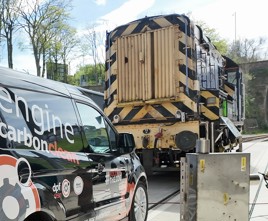Tests on a 1960s shunter have shown that hydrogen can make a diesel engine run more cleanly and cut fuel consumption.
The add-on system, which combines hydrogen production with carbon capture, has been developed by Advanced Hydrogen Technologies Group and is already used in automotive applications.
This railway study is a partnership between AHT and Harry Needle Railroad Company, a Midlands-based specialist in storage and maintenance of rail vehicles, and forms part of the Clean Futures programme run by the Black Country Innovative Manufacturing Organisation (BCIMO).
AHT’s system was put through its paces over two weeks at BCIMO’s Very Light Rail National Innovation Centre in Dudley, using an HNRC Class 08 shunter.
In the first week, a four-cell hydrogen generator cleaned the engine by removing residual carbon build-up. The following week, a bespoke ‘capture’ device was added, which further reduced harmful emissions and particulates to complete the process.
Overall, AHT reports that exhaust gas pollutant emissions were reduced by 22% and heavy particulates by 20%, with an average fuel saving of 8% compared with the pre-test baseline.
To determine these figures, independent testing specialist Atmo analysed more than 17,000 air pollutant and exhaust gas emission readings, with air quality sensors recalibrated each day to ensure that track and tunnel location, sensor placement, locomotive speed and electric current (amps) were consistent for every test.
“This was the ideal opportunity to solve the pressing issue of how to measure and quantify the benefits of hydrogen, which has been holding us back for years,” said HNRC’s Marcus Mayers.
“Access to both AHT’s specialist technology and BCIMO’s outstanding testing facilities has given us the data and backing we need to have a proven business investment case for upgrading our locomotives.”
AHT’s R4 system is fitted to the locomotive and electrolyses water to produce hydrogen, which is fed into the engine through the air intake.
AHT CEO Ben Kattenhorn explained: “The hydrogen is drawn to the carbon and due to its size, it gets inside of the carbon build-up and ‘pops’ when it gets to temperature.
“This dislodges the build-up from the engine, and the carbon then exits through the exhaust or (if also installed) is caught in the capture device.”
Kattenhorn said the hydrogen generator’s power draw is easy for the locomotive to handle, adding: “This had to be the case to make the system a commercially viable option.”
The system is permanently fixed, and produces enough hydrogen to consistently clean the locomotive, so he believes the fuel savings will increase from 8% over time.
He told RAIL the system that was tested “is available now and ready to be commercialised. AHT is in discussions with HNRC and a few other locomotive operators around installation of the system onto their fleets.”
















Login to comment
Comments
No comments have been made yet.